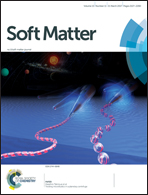Twisting microfluidics in a planetary centrifuge†
Abstract
This paper reports a twisting microfluidic method utilising a centrifuge-based fluid extruding system in a planetary centrifuge which simultaneously generates an orbital rotation and an axial spin. In this method, fluid extrusion from a micro-scale capillary to an ‘open-space’ solution or air enables release of the fluid from the capillary-based microchannel, which physically means that there is a release of fluids from a confined low-Reynolds-number environment to an open non-low-Reynolds-number environment. As a result, the extruded fluids are separated from the axial spin of the capillary, and the difference in the angular rates of the axial spin between the capillary and the extruded fluids produces the ‘twisting’ of the fluid. In this study, we achieve control of the twist of highly viscous fluids, and we construct a simple physical model for the fluid twist. In addition, we demonstrate the formation of twisted hydrogel microstructures (stripe-patterned microbeads and multi-helical microfibres) with control over the stripe pattern and the helical pitch length. We believe that this method will enable the generation of more sophisticated microstructures which cannot easily be formed by usual channel-based microfluidic devices. This method can also provide advanced control of microfluids, as in the case of rapid mixing of highly viscous fluids. This method can contribute to a wide range of applications in materials science, biophysics, biomedical science, and microengineering in the future.



 Please wait while we load your content...
Please wait while we load your content...